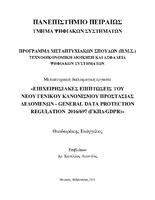Επιχειρησιακές επιπτώσεις του νέου Γενικού Κανονισμού Προστασίας Δεδομένων - General Data Protection Regulation 2016/679 (ΓΚΠΔ/GDPR)
Operational impact of the new General Data Protection Regulation 2016/679 (GDPR)

Προβολή/
Λέξεις κλειδιά
Προστασία δεδομένων ; Γενικός Κανονισμός Προστασίας Δεδομένων (ΓΚΠΔ) ; Νομικό πλαίσιο ; General Data Protection Regulation (GDPR)Περίληψη
Η παρούσα εργασία πραγματοποιήθηκε στο πλαίσιο συγγραφής της διπλωματικής εργασίας του προγράμματος μεταπτυχιακών σπουδών «Τεχνοοικονομική Διοίκηση και Ασφάλεια Ψηφιακών Συστημάτων» του τμήματος Ψηφιακών Συστημάτων του Πανεπιστημίου Πειραιώς. Το θέμα της διπλωματικής είναι: «Επιχειρησιακές επιπτώσεις του νέου Γενικού Κανονισμού Προστασίας Δεδομένων - General Data Protection Regulation 2016/679 (ΓΚΠΔ/GDPR)». Ο Ευρωπαϊκός κανονισμός είναι μια νομική πράξη της Ευρωπαϊκής Ένωσης που είναι δεσμευτική ως προς όλα τα μέρη του και ισχύει σε όλες τις χώρες μέλη της Ευρωπαϊκής Ένωσης. Ο ΓΚΠΔ/GDPR αφορά την προστασία των φυσικών προσώπων έναντι της επεξεργασίας δεδομένων προσωπικού χαρακτήρα και την ελεύθερη κυκλοφορία των δεδομένων αυτών και πρόκειται να αντικαταστήσει την Οδηγία του Ευρωπαϊκού Κοινοβουλίου 95/46/ΕΚ (24/10/1995) «για την προστασία των φυσικών προσώπων έναντι της επεξεργασίας δεδομένων προσωπικού χαρακτήρα και για την ελεύθερη κυκλοφορία των δεδομένων αυτών». Ο ΓΚΠΔ έχει κάποια χαρακτηριστικά Οδηγίας στο μέτρο που επιτρέπει στα κράτη μέλη εθνικές ρυθμίσεις για ορισμένες περιπτώσεις, όπως π.χ. για την ελάχιστη ηλικία συναίνεσης των ανηλίκων (που τίθεται στα 15 χρόνια στο ελληνικό νομοσχέδιο που τέθηκε σε διαβούλευση και στα 13 χρόνια από το αντίστοιχο κυπριακό που θα δημοσιοποιηθεί προσεχώς). Η ψήφιση του ΓΚΠΔ/GDPR έγινε στις 27 Απριλίου 2016 και η εφαρμογή του θα γίνει στις 25 Μαΐου 2018. Οι επιχειρήσεις - οργανισμοί θα πρέπει να συμμορφωθούν μέχρι την ημερομηνία εφαρμογής του κανονισμού. Στην εργασία αυτή μελετήθηκε η δημιουργία πρακτικού οδηγού, βήμα προς βήμα, συμμόρφωσης ενός οργανισμού με το νέο κανονισμό. Μέσα σε αυτήν αναλύεται η μεθοδολογία που ακολουθήθηκε για την δόμηση του οδηγού και η παρουσίαση αυτού. Πιο συγκεκριμένα, στο πρώτο κεφάλαιο, γίνεται συνοπτική αναφορά στο περιεχόμενο του ΓΚΠΔ/GDPR. Δίνεται μια περιγραφή του νομικού πλαισίου που καθορίζει τους κανόνες για όλους τους εμπλεκομένους. Αναλύονται οι αρμοδιότητες, τα δικαιώματα και οι υποχρεώσεις του καθενός. Στη συνέχεια, στο δεύτερο κεφάλαιο, παρουσιάζεται το πρακτικό μέρος της παρούσας εργασίας. Εδώ περιλαμβάνεται η μεθοδολογία δημιουργίας του οδηγού. Αναλύονται τα στάδια που οδήγησαν στην τελική μορφή του οδηγού και τα εργαλεία που δημιουργήθηκαν για αυτόν. Στο επόμενο κεφάλαιο, τρίτο κατά σειρά, παρουσιάζεται ο οδηγός με τα έξι βήματα που οδηγούν έναν οργανισμό - επιχείρηση στη συμμόρφωση με τον κανονισμό. Τα βήματα περιλαμβάνουν τον τρόπο δράσης από την αρχική κατάσταση του οργανισμού μέχρι και τη μέγιστη δυνατή συμμόρφωση. Στο τέταρτο κεφάλαιο προκύπτουν τα συμπεράσματα από την εμπειρία δημιουργίας του οδηγού. Αναφέρονται τα δυνατά και τα αδύνατα του σημεία καθώς και οι προτάσεις για μελλοντική βελτίωση.


